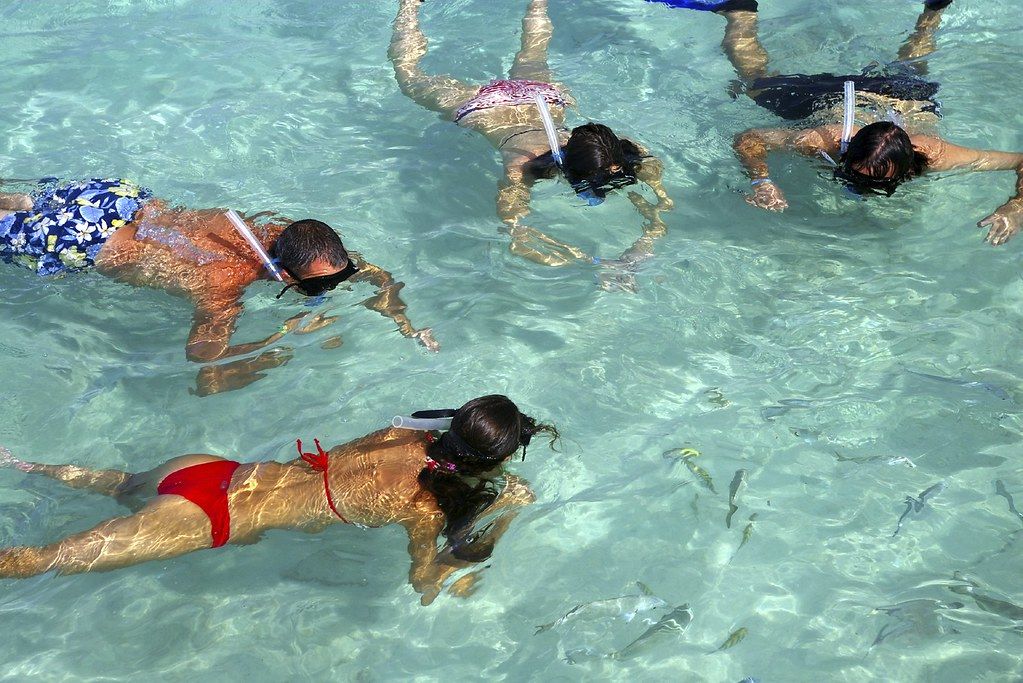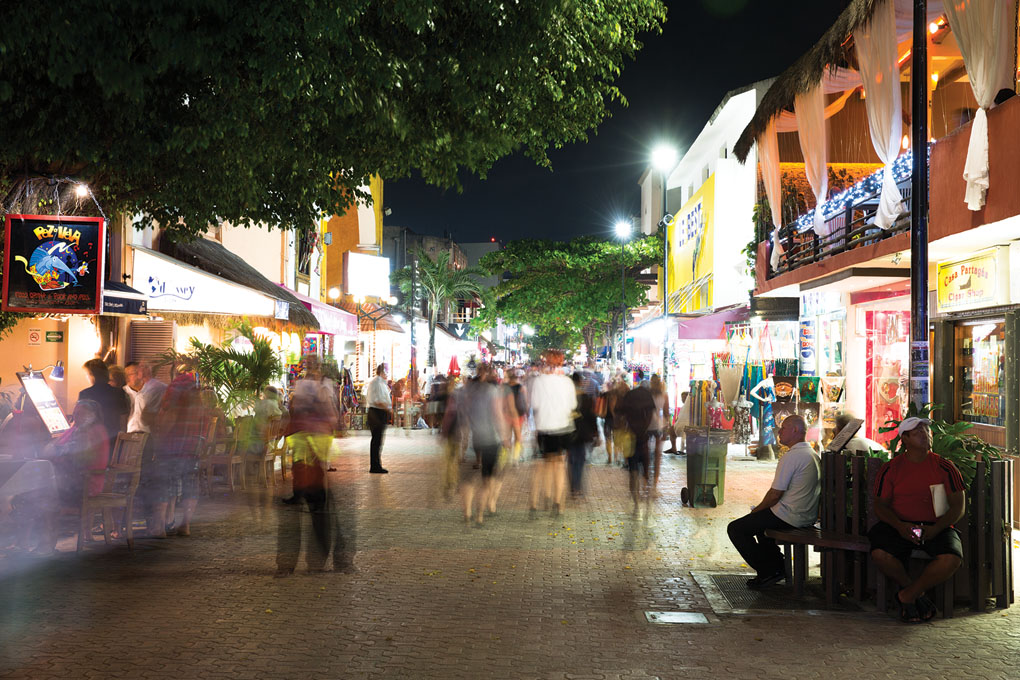The first time I stood on the coast of Mexico’s Riviera Maya, I was hooked. It was the water that really did me in: that unbelievably blue sea stretching into the dome of the sky overhead. The sand under my bare feet was so blindingly white that it didn’t get hot enough to burn my soles as I stood there, the mangroves at my back hiding treasures that I had yet to discover.
And that’s the thing: as tempting as it is to just stay put on that literally picture-perfect beach, don’t do it. There are too many things to discover, like the ancient temples tucked away in the jungle, a sanctuary for sea turtles, a fishing village turned foodie hotspot, and much more than I ever expected to find.

Mysterious Chichen Itza
The Riviera Maya gets its name from the ancient ruins that dot the region. Their influence is imprinted on the culture here, and making time to explore at least one Mayan remnant provides a fascinating window into the ancient people who lived here more than a thousand years ago. The most popular of the sites is Chichén Itzá, which is about a two-hour drive inland from the beachfront resorts of the Riviera Maya. It’s well worth the trip. The stepped pyramids, columned arcades, temples, and sacred ball courts are all that’s left of the city that served as the dazzling urban center of the Mayan world from A.D. 750 to 1200.
Visit Chichén Itzá at the spring or fall equinox to see the full effect of Mayan sophistication on display. Twice a year, the shadow of the serpent god Kukulkán appears to slither down the side of the perfectly positioned main pyramid known as the Castillo. Hundreds of travelers congregate to watch the shadowy snake’s slow progress. A thousand years ago in this very place, hundreds of Mayan people gathered to watch this very event. It’s a profound moment of humanity, as present-day crowds witness the remains of their ancient counterparts’ ingenuity.
On the way back from Chichén Itzá, make a stop at Valladolid, where you can get a glimpse of modern-day Mayan life. Here, many people wear the typical dress of the Maya, and colonial buildings scattered around the main plaza are painted in bright pastel colors. You may want to rush back to your hotel for a cerveza, but slow down here to get a taste of a more laid-back way of life.
Known for its cliff-top perch overlooking the Caribbean Sea, Tulum is the only known archaeological site of the Maya located on the coast. In the Mayan language, “Tulum” means “wall” or “fence”—and indeed, the sharp cliff below the ruins protected the ancient city from invaders. You get the whole history of the area there, plus it’s one of the best photo opportunities in the whole Riviera Maya region. These days, a staircase makes it easy to reach the protected beach cove at the base of the cliff. The crowds start to arrive around mid-morning, so arrive early in the morning and you can have the entire beach to yourself to swim beneath the walls of the Castillo.
About an hour inland from Tulum is Cobá, where stepping deep into the mangroves offers a different kind of reward. Situated around two lagoons, this is an archaeological site in the truest sense of the word. Many of the structures are still covered by the jungle, but don’t be fooled; this city is estimated to have housed nearly 50,000 people in its days as a hub of trade and agriculture. Cobá has one of the tallest pyramids in the region, and you can climb up to the top. It is very cool to see where the Mayan kings lived. But be warned—there is only a rope to help you back down the steep sides! Just take your time. It’s definitely worth it to see the view from the top. Spend time walking among the ruins and jungle. The peaceful, dappled light reminds you that you are in an ancient place—not an architectural tourist park.
Spectacular cenotes

The exploration of the Riviera Maya continues even underground in cenotes, the deep limestone sinkholes scattered throughout the Yucatán Peninsula. Filled with clear freshwater pools, many of these cenotes are connected to underground rivers flowing to the sea. One of the best ways to experience these underground pools and rivers is at Xcaret Park, where three rivers are hidden underground. As you float down through the maze of tunnels and channels, light filters through natural openings to the surface, illuminating marine fossils and rock formations with ghostly light.
It is no wonder that the Mayan people considered these cenotes and underground rivers the gateways to Xibalba, the underworld. The stories of the ancient people add an extra element of awe to your explorations of craggy caves filled with unearthly blue water and lined with stalactites and stalagmites shrouded in shadow. The cenotes are a very unique experience because they are so connected to the history of the region. With the rituals and blessings from Mayan priests, it’s just a really special experience.
Local food

If the cenotes and underground rivers are the hidden veins of the Riviera Maya, then Playa del Carmen is its beating heart. The town began as a small fishing village and has come of age as a hot spot for foodies with one restaurant after another lining the main drag of Fifth Avenue and its surroundings. It is mind-boggling. There are so many places—sushi, Argentinian, Italian. A literal hidden gem of a restaurant is Aldea Corazón, which has some of the best Mexican cuisine in the area. The menu focuses on fresh, local seafood and traditional Mexican dishes with a Mayan twist. It is in a cenote just off the street, surrounded by all this foliage and vegetation. It feels like you are in a cave, but you are right on Fifth Avenue.
Guests at The Royal Playa del Carmen should not miss a dinner at Asiana Restaurant, which overlooks Playa del Carmen. The view feels like you’re looking out over a small European town (and the tempura ice cream is a dessert you must indulge in).
I recommend walking to downtown Playa from the Riu Resort complex in the nearby community of Playacar. There are so many bars for all tastes and is definitely something to make everybody happy and have a great time. There certainly is an abundance of bars with different atmospheres. You can even count on catching a game if your favorite team is playing. End Zone Sports Bar, located on the corner of Fifth and Corazón, is always showing sporting events on its many televisions, so you don’t have to miss a game while on vacation.
During the day, enjoy cocktails on the sand at a beach club. Both Kool Beach and Mamita’s Beach Club host DJs during the day, so the atmosphere is always upbeat. As the sun goes down, head into town to dance the night away at a club like Mandala. When you’ve danced until you’re ready to drop, there’s still more to delight your taste buds. Even the late-night taquerías are incredible. There are so many different choices—don’t be afraid to try them out.
Lovely Akumal

The small town of Akumal means “place of the turtles” in the Mayan language, after the green and loggerhead sea turtles that nest on the beach. The unique ecology of the Riviera Maya makes Akumal the ideal place for turtles—and a variety of other marine life—with the protection of the mangrove jungles on one side and the coral reef on the other. Between the two are fields of seagrass that nurture turtles and protect their young. Akumal is the best place to snorkel with turtles in the whole region. Near shore, the giant sea turtles don’t so much swim as soar through the water over the gently waving mats of seagrass. The water is very clear, making it ideal for encountering the serene presence of a sea turtle.
At the nearby Akumal Ecological Center, you can join volunteer projects on monitoring the health of the coral reef, keeping a close eye on the sea turtle population, and participating in environmental education. During sea turtle nesting season, visitors can volunteer to join turtle walks to look for new nests, move eggs to protect hatchlings and release baby sea turtles into the sea.
Punta Maroma Beach

Now that you have spent time immersed in ancient history, exploring the caves of the underworld, chilling out in Playa, and swimming with turtles, it’s time to hit the beach … but not just any beach. Punta Maroma Beach is one of those places that defy superlatives. It is arguably the best beach in the Riviera Maya for the views alone, but there’s much more to this stretch of sand than a place to lay out in the sun. Maroma Adventures is a very well-developed center of activities. You have all your activities, beach chairs for relaxing, you can have lunch, and do some low-key shopping for souvenirs. It has the best variety of things to do and it’s so organized—you can go horseback riding, ATVing, go on a camel ride, swim with dolphins or just do nothing at all.
It’s true that Maroma Adventures has all the activities you could dream up—and quite possibly some that you wouldn’t even think of, including those camel rides along the coast. You would never guess that some of the best views of the beach can be had from the (very tall) back of a camel. The beach club is also home to a new dolphinarium. It is the largest dolphin habitat in the Riviera Maya, and has tons of different kinds of activities for all ages. The professional trainers are knowledgeable and the dolphins are friendly, particularly the pair named Hidalgo and Morelos.
Snorkeling and playing golf
The snorkeling at Maroma is excellent, as the Mesoamerican Reef is just offshore. It is the world’s second-longest barrier reef system behind Australia’s Great Barrier Reef. At around 7,000 years old, it’s home to more than 900 marine species along its 700-mile stretch, so keep your eyes open for bright coral, angelfish, yellowtail snapper, triggerfish, barracudas, and arrowhead crabs.

Riviera Maya is one of the Caribbean’s top golf destinations, with flagship courses by some of the biggest names in golf course design. Bonus: you can play the day away without blowing your vacation budget. Several resorts in the Riviera Maya have partnerships with golf courses or have their own golf courses right on the property. One of the top golf courses in the region is El Camaleón (The Chameleon), designed by Greg Norman. The name is well-deserved as the course’s character changes between mangroves, cenotes, lagoons, and the beach. El Camaleón hosts the OHL Classic at Mayakoba every November, one of only a few PGA Tour events held outside of the United States.
Resorts are also stepping up their golf game with on-site golf clubs. The Iberostar Playa Paraíso Golf Club, for example, is designed by P.B. Dye and is accessible from any of the five resorts located within the complex. Nearer to Cancún, the Moon Palace has 27 holes of golf on the property, including one of only two Jack Nicklaus Signature Golf Courses in the region. For neophytes, Moon Palace also has its unique Jack Nicklaus Academy with certified instructors. Further south, near Akumal, test your game on the Riviera Maya Golf Club designed by Robert Trent Jones II. The course is impressively challenging and its partnership with Grand Bahía Principe Akumal makes it more accessible—and affordable—to visitors.

My love story with the Riviera Maya began at first sight and only grew from there as I explored its diverse adventures. I am not unique in this respect; thousands of travelers flock here all year long. But what I discovered among the mangroves, along the beaches, in the ancient temples, and hidden in the cenotes is the truth about what makes this region so special: the deep pride and genuine love that the people here have for their home, which they are so eager to share with the travelers who—like me—are only beginning to unlock the treasures of the Riviera Maya.
Check out more articles about Mexico:

